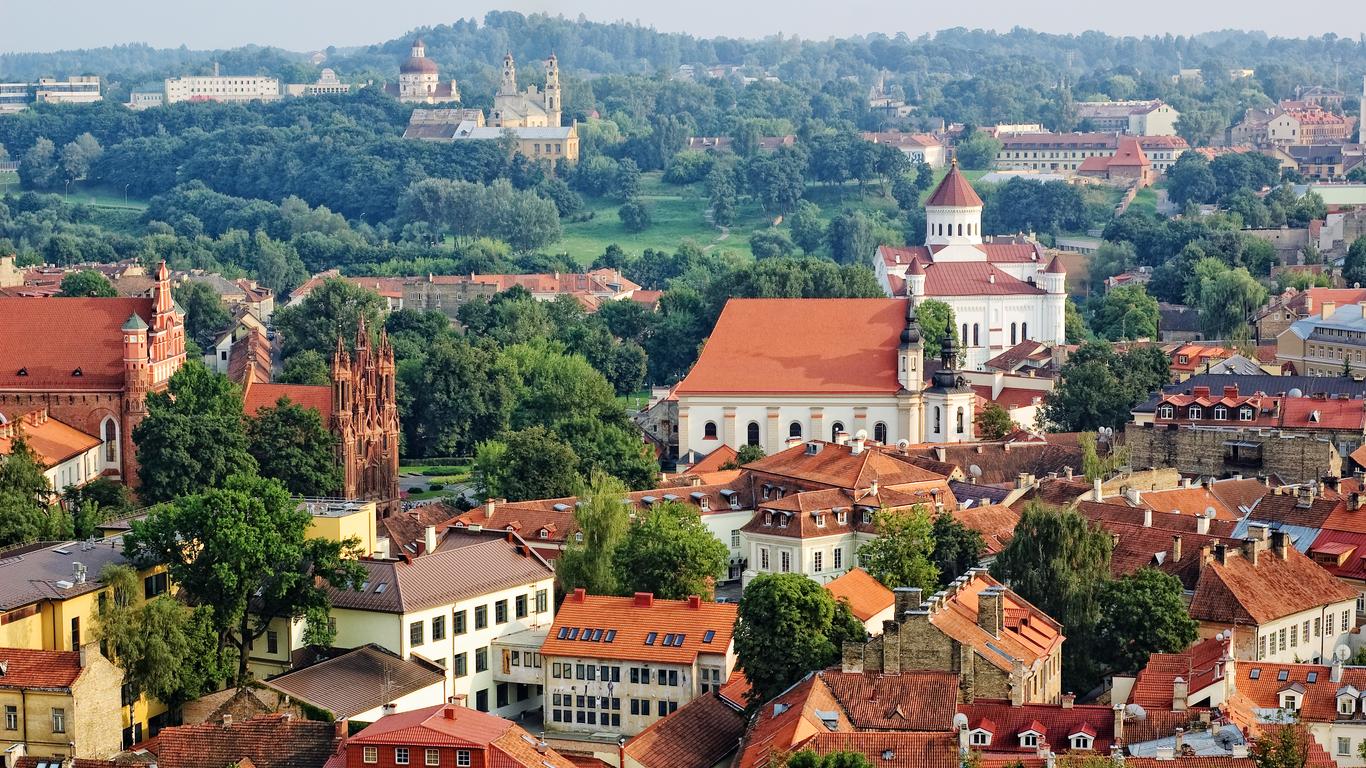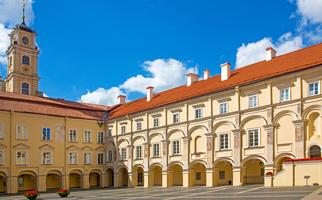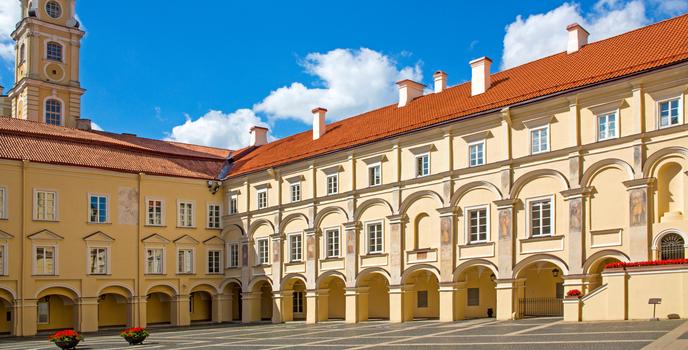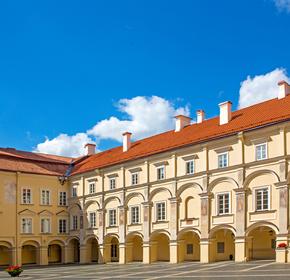
Vilnius travel guide
Vilnius Tourism | Vilnius Guide
You're Going to Love Vilnius
With cobblestone streets and a wealth of gorgeous architecture in Europe's largest baroque old city center, it's no secret why Vilnius is one of the most popular tourist destinations in the Baltic region. The modern era adds a busy business center, shopping and a hot night life scene to round out the experience.

Top 5 Reasons to Visit Vilnius
1. Beautiful Buildings
Along with ornate baroque architecture, the historic city center is also full of stunning examples of medieval Gothic and neoclassical structures that line its cobblestone streets.
2. Lively Night Life
Vokieciu, Vilniaus, and Islandijos streets are where you will find bars and night clubs that will keep you busy until the early ours of the morning.
3. Arts and Culture
Through summertime, open air concerts to theater and performing arts, galleries and more, there is a lot to explore in the city's thriving arts scene.
4. Fantastic Shopping
Along with international designer boutiques like BCBG Max Azria, Vilnius is home to a bustling local designer scene. It is also a traditional center for glassblowing and textile arts.
5. Explore History
There are centuries of history waiting to be discovered in the city, from the ramparts of the hilltop Gedimas Castle & Museum - dating from the 15th century - to the more modern Museum of Genocide Victims.
What to do in Vilnius
1. Vilnius Cathedral: The Center of Lithuania's Catholic Culture
Visit the mighty Vilnius Cathedral and you'll be treated to a dual delight: a view of Lithuania's imperial history and a sampling of some of the most inspiring art and architecture in the country. Famous Lithuanians and Poles are buried in the crypt, including some of the greatest kings and queens of the region. Up above, the cathedral is decorated with beautiful paintings and frescoes that date from the 16th to 19th centuries. Interestingly enough, the cathedral is built on the same site of a pagan temple, and altars and other remnants of the previous holy site have been uncovered throughout the cathedral's existence.
2. Trys kryžiai: A Monument Not to Be Missed
During your Vilnius visit, you're sure to see the Three Crosses on top of the Bleak Hill in Kalnai Park. The crosses mark the spot where seven Fransiscan monks were said to have been beheaded. For the last 400 years, the hill has housed three crosses to mark the spot, and just over 100 years ago a concrete monument was designed to immortalize the location. In addition to its religious significance, the three crosses are perhaps the best spot to take in the sight of the city, which unfurls below an observation deck located at the top of the monument.
3. Gates of Dawn: The Gate of Dawn
Easily one of the most important places in all of Lithuania, the Gate of Dawn used to guard the city of Vilnius from attackers. Today, it's the last remaining city gate. Visit and you'll be awed by the beauty and history of the place. You're also likely to encounter worshipers at the icon of Our Lady of the Gate of Dawn. This icon has been housed in the gate for hundreds of years, and many miracles have been attributed to it. Catholic and Orthodox pilgrims have placed thousands of offerings on the walls, and masses are held on the spot in Lithuanian and Polish. It remains one of the world's most enduring images of Mary.
4. Lietuvos Didžiosios Kunigaikštystės valdovų rūmai Vilniaus žemutinėje pilyje: Seat of Vilnius' Historic Rulers
The Vilnius Castle Complex is an impressive group of historic structures located next to the confluence of the Neris and the Vilnia. Inside, the Palace of the Grand Dukes of Lithuania can be found. Here, the dukes of Lithuania, as well as the kings of Poland, had their home and administrative center. Today, the building continues to hold importance: in 2013, it was one of the main buildings used as a gathering place for the heads of European countries.
5. Vilniaus universitetas: One of the Most Storied Universities in Northern Europe
Vilnius University is the oldest university in the Baltic states and one of the largest in all of northern Europe. The beautiful campus bears testament to this proud heritage. An active partner in international scientific and academic investigations, this university hosts students from around the world, making it a great place for young people to visit in case they are considering attending.


1. Vilnius Cathedral: The Center of Lithuania's Catholic Culture
Visit the mighty Vilnius Cathedral and you'll be treated to a dual delight: a view of Lithuania's imperial history and a sampling of some of the most inspiring art and architecture in the country. Famous Lithuanians and Poles are buried in the crypt, including some of the greatest kings and queens of the region. Up above, the cathedral is decorated with beautiful paintings and frescoes that date from the 16th to 19th centuries. Interestingly enough, the cathedral is built on the same site of a pagan temple, and altars and other remnants of the previous holy site have been uncovered throughout the cathedral's existence.
2. Trys kryžiai: A Monument Not to Be Missed
During your Vilnius visit, you're sure to see the Three Crosses on top of the Bleak Hill in Kalnai Park. The crosses mark the spot where seven Fransiscan monks were said to have been beheaded. For the last 400 years, the hill has housed three crosses to mark the spot, and just over 100 years ago a concrete monument was designed to immortalize the location. In addition to its religious significance, the three crosses are perhaps the best spot to take in the sight of the city, which unfurls below an observation deck located at the top of the monument.
3. Gates of Dawn: The Gate of Dawn
Easily one of the most important places in all of Lithuania, the Gate of Dawn used to guard the city of Vilnius from attackers. Today, it's the last remaining city gate. Visit and you'll be awed by the beauty and history of the place. You're also likely to encounter worshipers at the icon of Our Lady of the Gate of Dawn. This icon has been housed in the gate for hundreds of years, and many miracles have been attributed to it. Catholic and Orthodox pilgrims have placed thousands of offerings on the walls, and masses are held on the spot in Lithuanian and Polish. It remains one of the world's most enduring images of Mary.
4. Lietuvos Didžiosios Kunigaikštystės valdovų rūmai Vilniaus žemutinėje pilyje: Seat of Vilnius' Historic Rulers
The Vilnius Castle Complex is an impressive group of historic structures located next to the confluence of the Neris and the Vilnia. Inside, the Palace of the Grand Dukes of Lithuania can be found. Here, the dukes of Lithuania, as well as the kings of Poland, had their home and administrative center. Today, the building continues to hold importance: in 2013, it was one of the main buildings used as a gathering place for the heads of European countries.
5. Vilniaus universitetas: One of the Most Storied Universities in Northern Europe
Vilnius University is the oldest university in the Baltic states and one of the largest in all of northern Europe. The beautiful campus bears testament to this proud heritage. An active partner in international scientific and academic investigations, this university hosts students from around the world, making it a great place for young people to visit in case they are considering attending.


Where to Eat in Vilnius
You'll enjoy the unusual Irish-Lithuanian menu at Bistro 18, where main dishes start at about EUR5.50. For a classic Lithuanian cafe experience, choose Pinavija, where pastries start at only EUR2.
When to visit Vilnius
The climate of Vilnius is cool and markedly seasonal, with most visitors opting to arrive during the warmer spring and summer. Temperatures range between 60°F and 70°F between May and September.
How to Get to Vilnius
Plane
The Vilnius International Airport (VNO) is located about 3.5 miles from the city center. There is frequent bus service to the city, with fares of only EUR1. Trains are another option, with fares starting at EUR0.70.
Train
Vilnius is a major rail hub, with train connections to Moscow, St. Petersburg, Minsk and many other major centers.
Car
There are good road connections between Vilnius and nearby Kaunas and Panevėys, with a well maintained highway system that links the city to most major centers in the country.
Bus
Eurolines and ECOLINES operate intercity service to and from Vilnius and many major centers throughout Europe. Connections to Warsaw are available through PolskiBus.
Airlines serving Vilnius
Where to stay in Vilnius
Baroque Old Town - this neighborhood actually dates back to the 13th century, and it's where every street is packed with historic churches like St. Casimir's and buildings like the neo-classical Town Hall.
Popular Neighborhoods in <b>Vilnius</b>
Uzupis - this artistic enclave - a self-declared republic - is where you'll find art galleries along with artisan boutiques and cafes with a bohemian ambiance.
Antakalnis - this is one of the city's oldest suburbs, and it's where you'll find the historic Antakalnis Cemetery and beautiful Baroque Saints Peter and Paul church along with an upscale shopping and dining scene.
Where to stay in popular areas of Vilnius
Most booked hotels in Vilnius
How to Get Around Vilnius
Public Transportation
Vilnius is served by an extensive system of buses and trolley buses, with single fares that start at EUR0.64. A day pass costs EUR3.48.
Taxi
Taxis are readily available in the city. An average fare within the city should cost about EUR10-15.
Car
Parking can be at a premium, especially in the older areas of the city. A compact rental starts at about EUR16.
The Cost of Living in Vilnius
Shopping Streets
In between gawking at the gorgeous buildings, you can shop at designers like Burberry, along with local designers and products, in the old city on Stiklas street.
Groceries and Other
RIMI and Maxima XX are supermarket chains you'll find in multiple locations throughout the city. A quart of milk costs EUR0.80 and a dozen eggs about EUR1.60.

